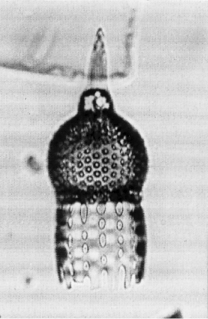 Calocyclas
turris Ehrenberg
Calocyclas
turris Ehrenberg Calocyclas
turris Ehrenberg
Calocyclas
turris EhrenbergCalocyclas turris Ehrenberg, 1873, p.218; 1875, pl.18, fig.7; Foreman, 1973, p.434
Shell of three segments, with the collar and lumbar strictures expressed externally. Cephalis subspherical, poreless or with a pitted surface, bearing a conical horn twice to three times the length of the cephalis. In late, robust forms, the cephalis is enclosed in the base of the horn, which terminates in a knob-like or roughened thickening. Thorax inflated-hemispherical with circular pores arranged quincuncially (long axis of the quincunx horizontal). Thick-walled specimens have deep-set pores surrounded by hexagonal poreframes. At the junction of these pore-frames small thorns may develop. The cylindrical abdomen consists of ~20 lamellar feet joined by bars to form the third segment with longitudinal rows of pores. This abdomen is commonly five pores long. The elongated abdominal pores are up to four times as long as the thoracic ones. In late forms the number of longitudinal lamellae is reduced, and they become thickened, rib-like. The distal portion of the abdomen, when preserved, consists of tapering, unjoined, prolongations of the lamellae (Sanfilippo, unpublished).
Based on 40 specimens. Total length (excluding horn) usually 170-220 µm (but may be up to 505 µm). Length of cephalothorax 105-160 µm; maximum breadth 100-145 µm (but may be up to 165 µm) (Sanfilippo, unpublished).
The lamellar feet are joined by bars to form an abdomen with longitudinal rows of pores (Riedel and Sanfilippo, 1978a).
C. turris is distinguished from its ancestor C. hispida (Ehrenberg, 1873) by its lamellar feet being joined by bars to form an abdomen with longitudinal rows of pores, and from its descendant C. bandyca by not having the lamellar feet reduced in number and developed into strong, divergent, conical legs.
This short ranged species varies in thoracic size, length and robustness of the abdomen, and in the thoracic pores becoming more regularly longitudinally arranged in later forms. Prior to the speciation of C. bandyca the number of longitudinal abdominal longitudinal lamellae is reduced, and they become substantially thickened, while the transverse bars become fewer and much thinner (Sanfilippo, unpublished).
C. turris is found in moderate abundance in tropical samples of late Eocene age. It evolved from Calocyclas hispida within the Cryptocarpium azyx Zone and became extinct within the Cryptocarpium ornatum Zone.
This species evolved from C. hispida by the feet becoming joined to form an abdomen, and gave rise to C. bandyca. All three species may co-occur.
Additional illustrations can be found in Riedel and Sanfilippo, 1978a, pl.3, figs.7-8.